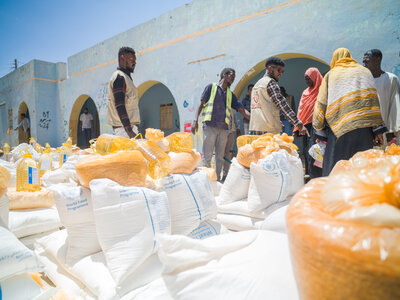Emergency
Sudan
- 21.2 million
- people facing acute hunger
- 4 million
- people supported by WFP each month
- US$662 million
- additional funding needed to reach 8 million people each month
Famine conditions have been confirmed in Al Fasher and Kadugli, with the risk of famine in 20 additional areas across Greater Darfur and Greater Kordofan.
In the western regions of Sudan – notably North Darfur, South Darfur, West Kordofan and South Kordofan – conflict and severely restricted access is driving a sharp deterioration in hunger and malnutrition.
An estimated 21.2 million – 45 percent of the population – are facing high levels of acute food insecurity, according to the latest Integrated Food Security Phase Classification.
In areas where violence has subsided – allowing humanitarian access and market recovery – food security has begun to improve. However, these improvements are highly localized – the wider crisis has shattered the economy and vital services, and a lot of the infrastructure has been damaged or destroyed.
From February 2026, hunger is expected to worsen as food stocks run out and fighting continues.
The World Food Programme (WFP) and partner UN agencies are calling for an end to hostilities and safe, unimpeded and sustained humanitarian access. This is urgently needed to prevent further loss of life and protect livelihoods.
Compounding these huge challenges, the gap between humanitarian needs and existing resources is massive. Millions are being cut off from life-saving aid as WFP is forced to prioritize people facing the most extreme levels of hunger.
We need an additional US$662 million to reach 8 million people a month.
What the World Food Programme is doing to respond to the Sudan emergency
-
Emergency response
-
Funding shortfalls have forced WFP to prioritize the most hungry communities. We are reaching over 4 million people a month, including 1.5 million in the hardest-hit areas across Darfur, Kordofan, Khartoum and Al Jazira. We are reaching around 80 percent of people in the 27 famine and risk-of-famine areas. WFP has also expanded assistance in areas where conflict has subsided, such as Khartoum State, Al Jazira, and Sennar, where over 800,000 people are supported every month.
-
Resilience
-
UNHAS
-
Logistics
-
Emergency Telecommunications Cluster

